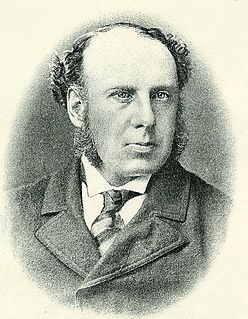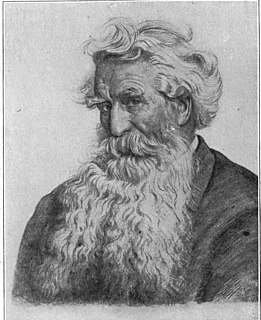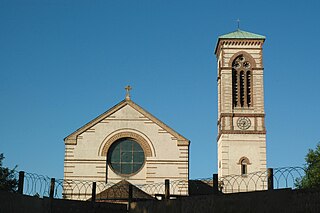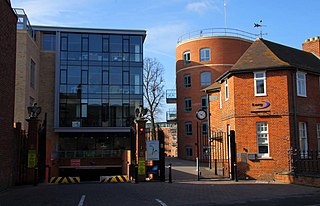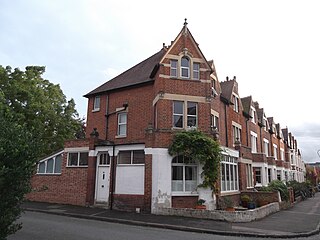
William Ward (1807 – 20 July 1889) was a Victorian Mayor of the city of Oxford, in England. [1]

Oxford is a university city in south central England and the county town of Oxfordshire. With a population of approximately 155,000, it is the 52nd largest city in the United Kingdom, with one of the fastest growing populations in the UK, and it remains the most ethnically diverse area in Oxfordshire county. The city is 51 miles (82 km) from London, 61 miles (98 km) from Bristol, 59 miles (95 km) from Southampton, 57 miles (92 km) from Birmingham and 24 miles (39 km) from Reading.
William Ward was the son of Henry Ward (1780–1852), who himself was the son of Abraham Ward from Warwickshire. [1] His mother was Sarah Ward (1779–1858), the daughter of Abraham Ward (1739–1817) from Stafford and Oxford.
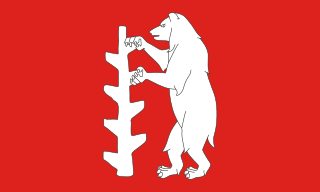
Warwickshire is a landlocked county in the West Midlands region of England. The county town is Warwick, although the largest town is Nuneaton. The county is famous for being the birthplace of William Shakespeare.

Stafford is the county town of Staffordshire, in the West Midlands of England. It lies approximately 16 miles (26 km) north of Wolverhampton, 18 miles (29 km) south of Stoke-on-Trent and 24 miles (39 km) north-west of Birmingham. The population in 2001 was 63,681 and that of the wider borough of Stafford 122,000, the fourth largest in the county after Stoke-on-Trent, Tamworth and Newcastle-under-Lyme.
Ward became a coal merchant as his father had been before him. His business was based at the canal wharf on the Oxford Canal in Jericho, Oxford.

The Oxford Canal is a 78-mile (126 km) narrow canal in central England linking Oxford with Bedworth via Banbury and Rugby. Completed in 1790, it connects to the River Thames at Oxford and is integrated with the Grand Union Canal — combined for 5 miles close to the villages of Braunston and Napton-on-the-Hill, a canal which soon after construction superseded much of its traffic.
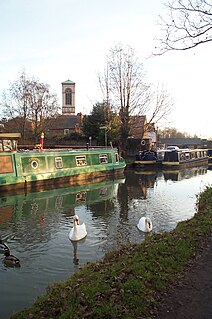
Jericho is an historic suburb of the English city of Oxford. It consists of the streets bounded by the Oxford Canal, Worcester College, Walton Street and Walton Well Road. Located outside the old city wall, it was originally a place for travellers to rest if they had reached the city after the gates had closed. The name Jericho may have been adopted to signify this 'remote place' outside the wall.
William Ward married Harriet Timmis on 20 July 1830. They lived at the junction of St John Street and Alfred Street (now Pusey Street) in central Oxford. The house is now 22 St John Street. Eleven children were born to them in this house between 1832 and 1847, all baptised at St Giles' Church nearby.

St John Street is a street in central Oxford, England. The street mainly consists of Georgian-style stone-faced Grade II listed terraced houses. It was built as a speculative development by St John's College starting in the 1820s and finishing in the 1840s at the start of the Victorian era.

Pusey Street links the wide thoroughfare of St Giles' Street to the east with St John Street to the west in the St John Street area of central Oxford, England. Pusey Street, formerly called Alfred Street, was renamed in honour of Edward Bouverie Pusey in 1926. The renaming also avoided confusion with another Alfred Street to the south.

St. Giles' Church is a church in North Oxford, England. It is at the northern end of the wide thoroughfare of St Giles', at the point where it meets Woodstock Road and Banbury Road. It stands between where Little Clarendon Street joins Woodstock Road and Keble Road joins Banbury Road.
Ward was Mayor of Oxford in 1851–2 and again in 1861–2.
In 1868, Ward was elected the first President of the newly formed Oxford Constitutional Association. He became known as the father of modern Conservatism in Oxford. [1] Ward was also a leader in the Oxford Movement. He donated the land in Jericho for the building of St Barnabas' Church in 1869.
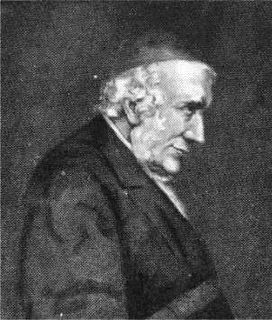
The Oxford Movement was a movement of High Church members of the Church of England which eventually developed into Anglo-Catholicism. The movement, whose original devotees were mostly associated with the University of Oxford, argued for the reinstatement of some older Christian traditions of faith and their inclusion into Anglican liturgy and theology. They thought of Anglicanism as one of three branches of the One, Holy, catholic, and Apostolic Church.
Ward erected a drinking fountain on the site of the spring at Walton Well, located in Walton Well Road, with a plaque dated 1885. [2] [3]
Ward died on 20 July 1889 aged 82 and was buried in the family vault at St Mary Magdalen's Church. His wife died on 26 July 1876 aged 67 and was buried in the same church.


